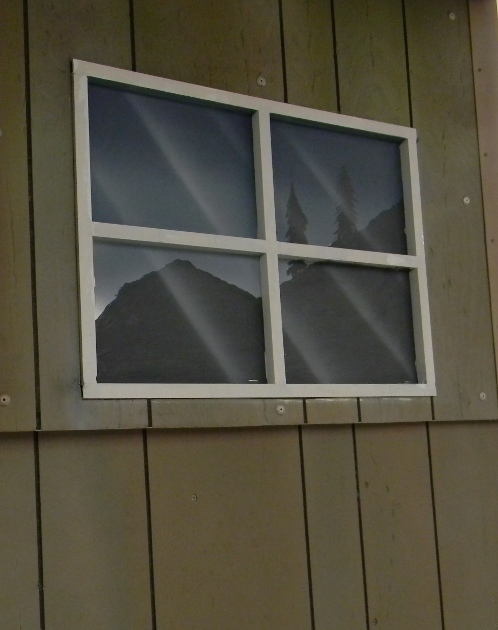You are hereHow to paint a faux stone chimney for stage or display
How to paint a faux stone chimney for stage or display
The friendly crew at A Welding was given the job of making a small cabin to be used at a convention in Texas. It had to be lightweight and portable, and transport in a small area. So they made it from box tube aluminum, with a porch floor that folds up and a porch roof that retracts (slides into) the cabin. I've seen lots of old cabins around here, as well as old barns, so I have a good amount of reference material. The work is being done at:
.
A Welding & Fabrication Shop
330 Wears Valley Road, Pigeon Forge Tn. 37863
Phone (865) 428-5555
email: aweldingfabricationshop@yahoo.com
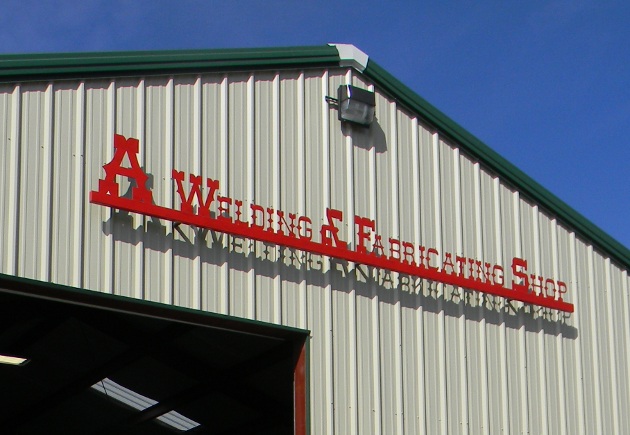
.
While the crew was finishing the sheet aluminum chimney, I set about making the plywood door look as though it was made of boards nailed together. Time was of the essence, because the project was a rush, and for reasons of economy. You've got to be able to knock this stuff out quickly if you're doing it for a living. So the board look was all spray, it's faster than brushes. What you see in the picture below is one of the pieces of sheet metal that I used as masks. I've already done the vertical boards. here I'm doing an angled support. When making the individual boards, I used three pieces of sheet metal as masks. One on each side of the board, and one covering the place where the angled board goes. Here in the picture I'm applying a thinned off-black shadow to make the board look raised or three-D. Seldom do I use straight black in illustration work. I made another page about faux barn boards, it can be seen here:
Faux barn boards for stage
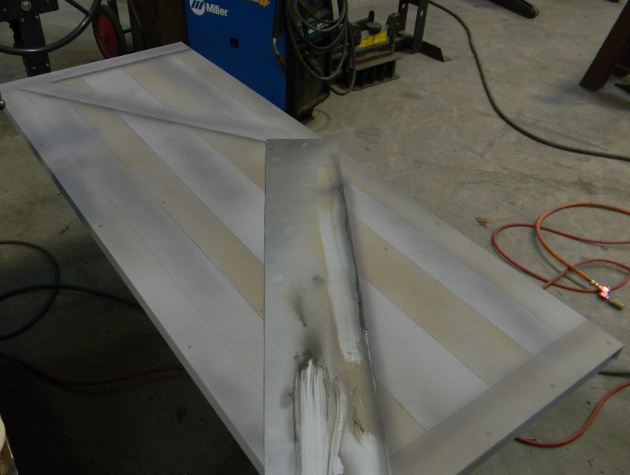
In the next picture you see the finished door. This is just a piece of plywood with some latex paint sprayed on it.
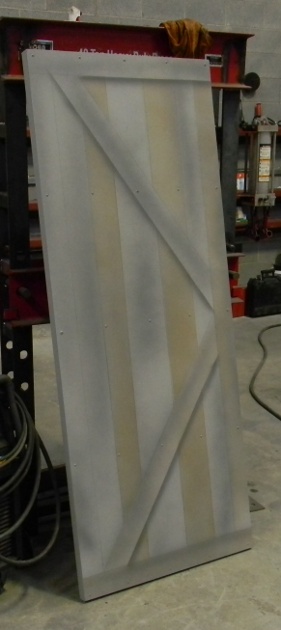
The crew finished the upper part of the aluminum chimney. (This is just for looks; if you're searching the internet, this chimney is not for actual use. Aluminum conducts heat very well, and this would be a first class fire hazard.) I rolled on a color that would be the mortar between the fake stones. When that was dry, I used a pencil to draw in the shapes of the stones. This is something you have to think about, you don't want patterns to start showing. Imagine how the process would go if this was real stone. Some taller, some wider, off angles, and few truly parallel lines. I think a real stone mason would make sure all joints were offset from each other, for greater strength. These rocks are painted on with a brush. Sometimes I just demand a hard edge, and spraying without a mask seldom delivers that. Be careful about just mixing straight black and white to make a gray. I prefer to spell it GREY, but I guess that's British. Anyway, the reason is that while in theory black and white are neutral, in reality, black is usually made from very dark blue pigments. That's why it will make an earthy green when mixed with yellow. Another paint reality to watch for is what type of paint you're using. Some cheaper paints have less coverage. Their durability might be OK, but the amount of pigment can throw off your color mixing operation if you're using them with a higher coverage paint.
What will happen most of the time when you mix black and white is that you'll get a very cold, blue-ish gray. To counteract that, warm it up with something like an orange-red. Straight red will make blue+white+red = strange purplish color. You can mix the stone color variations before you start, in containers, or have the white, orange-red, and brown nearby, to mix in as you go. Just like an artist with a palette. See, you're an artist now. Paint the stones around the edge, below is a picture at this stage.
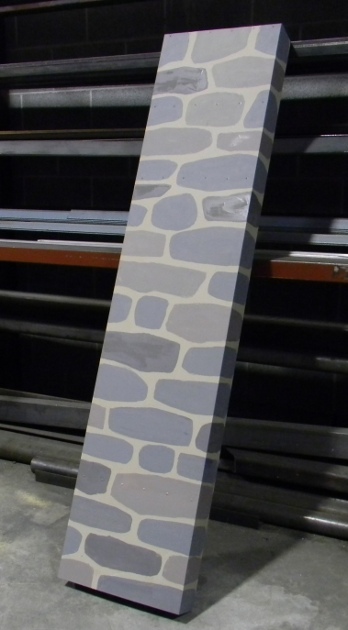
Next is a picture after I sprayed a shadow on and under each rock. It's a simple process, it sprays both at one time. I think I used a detail gun with the shadow, and an airbrush for the white highlights. You need to be comfortable with your spray gun, don't be nervous. Practice on a nearby board or piece of cardboard. Distance from the surface and speed you move are variables that work together. Not as complicated as it sounds.
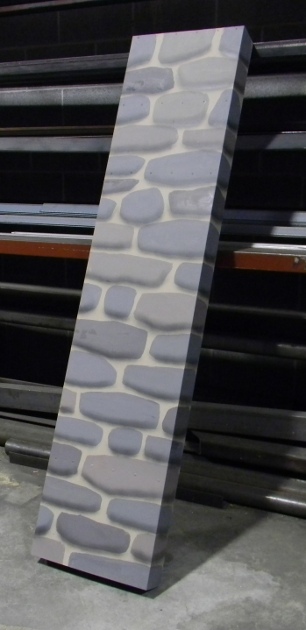
Here's a closer picture from the lower part of the chimney.
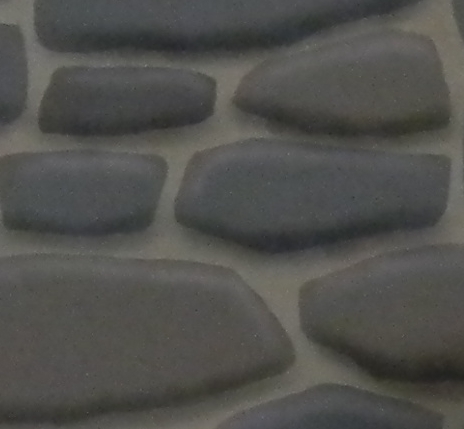
Next is a picture of the chimney's lower part, so you can see the shape.
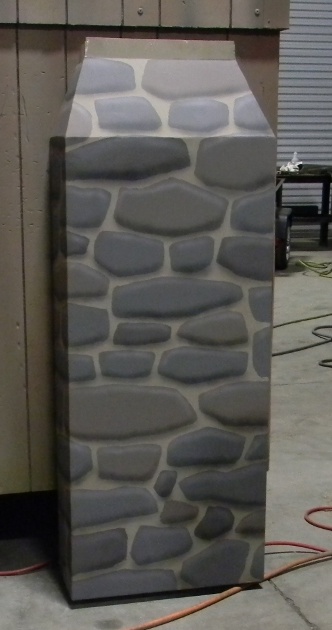
I also had to paint a fake window. This was a little more difficult, as I had to work around the very real frame pieces. I did a grayish blue blending down toward white, for the sky, then did a simple mountain silhouette scene. The advantages to this simplicity are: It's quickly recognized, it's fast to render, and it's easier to duplicate on the two fake windows. Only one is shown here. The last step is to take a piece of scrap sheet metal as a straight mask edge, and paint the off white angled glare lines. One edge will be crisper than the other, but it won't matter. I first saw this trick years ago for making glare starbursts with an airbrush. You spray two angled (not vertical and horizontal) lines crossing, like a tilted plus sign. Then you spray a dot in the middle, blending it out a little. Really nice little glare star thing. Anyway, below is the window. That's all for now, be careful with your color mixing; most are dull, and be confident and thoughtful about your spray methods. You'll like what you do.
